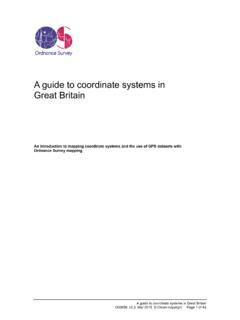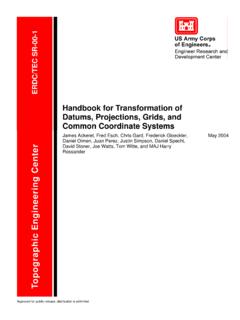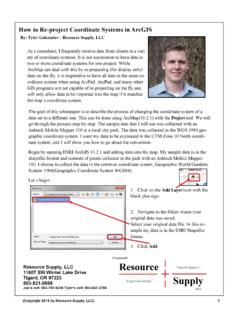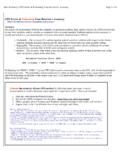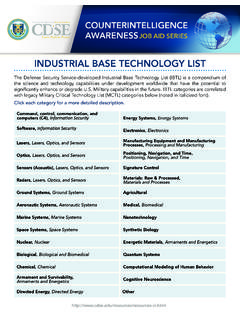Transcription of D00659 A Guide to coordinate systems in Great …
1 A Guide to coordinate systems in Great Britain D00659 Mar 2015 Crown copyright Page 1 of 43 A Guide to coordinate systems in Great Britain An introduction to mapping coordinate systems and the use of GPS datasets with Ordnance Survey mapping A Guide to coordinate systems in Great Britain D00659 Mar 2015 Crown copyright Page 2 of 43 Contents Section Page no 1 Introduction .. 3 Who should read this booklet? .. 3 A few myths about coordinate systems .. 4 2 The shape of the Earth .. 6 The first geodetic question .. 6 Ellipsoids.
2 6 The Geoid .. 7 Local geoids .. 8 3 What is position? .. 9 Types of coordinates .. 9 Latitude, longitude and ellipsoid height .. 9 Cartesian coordinates .. 10 Geoid height (also known as orthometric height) .. 11 Mean sea level 12 Eastings and northings .. 14 We need a 15 Datum definition before the space age .. 16 Realising the datum definition with a Terrestrial Reference Frame .. 16 Summary .. 17 4 Modern GPS coordinate systems .. 18 World Geodetic System 1984 (WGS84) .. 18 Realising WGS84 with a TRF .. 19 The WGS84 broadcast TRF.
3 19 The International Terrestrial Reference Frame (ITRF) .. 20 The International GNSS Service (IGS) .. 20 European Terrestrial Reference System 1989 (ETRS89) .. 21 5 Ordnance Survey coordinate systems .. 22 OS Net .. 22 National Grid and the OSGB36 TRF .. 23 The OSGB36 datum .. 23 The OSGB36 TRF .. 24 Relative accuracy of OSGB36 control points .. 25 Ordnance Datum Newlyn .. 25 The ODN datum .. 25 The ODN TRF .. 25 Relative accuracy of ODN bench marks .. 26 Other height datums in use across Great Britain .. 26 The future of British mapping coordinate systems .
4 27 6 From one coordinate system to another: geodetic transformations .. 27 What is a geodetic transformation? .. 27 Helmert datum transformations .. 29 National Grid Transformation OSTN02 (ETRS89 OSGB36) .. 31 National Geoid Model OSGM02 (ETRS89-Orthometric height) .. 31 ETRS89 to and from ITRS .. 32 Approximate WGS84 to OSGB36/ODN transformation .. 33 7 Transverse Mercator map projections .. 33 The National Grid reference convention .. 35 8 Further information .. 36 A Ellipsoid and projection constants .. 37 Shape and size of biaxial ellipsoids used in the UK.
5 37 Transverse Mercator projections used in the UK .. 37 B Converting between 3D Cartesian and ellipsoidal latitude, longitude and height coordinates .. 38 Converting latitude, longitude and ellipsoid height to 3D Cartesian coordinates .. 38 Converting 3D Cartesian coordinates to latitude, longitude and ellipsoid height .. 39 C Converting between grid eastings and northings and ellipsoidal latitude and longitude .. 40 Converting latitude and longitude to eastings and northings .. 40 Converting eastings and northings to latitude and longitude.
6 41 D Glossary .. 43 A Guide to coordinate systems in Great Britain D00659 Mar 2015 Crown copyright Page 3 of 43 1 Introduction Who should read this booklet? This booklet is aimed at people whose expertise is in fields other than geodesy, who need to know the concepts of coordinate systems in order to deal with coordinate data, and who need information on using mapping coordinate systems in Great Britain. It explains: the basic concepts of terrestrial1 coordinate systems ; the coordinate systems used with the Global Positioning System (GPS) and in OS mapping; and how these two relate to each other.
7 Although this booklet deals with the GPS system, the concepts and techniques can also be applied to other Global Navigation Satellite systems (GNSS), for example, Russian GLONASS, European Galileo and Chinese BeiDou Navigation Satellite System (BDS). The subject of geodesy deals, amongst other things, with the definition of terrestrial coordinate systems . Users of coordinates are often unaware that this subject exists, or that they need to know some fundamental geodetic concepts in order to use coordinates properly. This booklet explains these concepts.
8 If you work with coordinates of points on the ground and would like to know the answers to any of the following questions, or if you don t understand the questions, this booklet is a good place to start: How do geodesists define coordinate systems that are valid over large areas? What is difficult about this task, anyway? Why can t we all just use one simple coordinate system for all positioning tasks? What exactly is WGS84? How accurate is it? How does WGS84 relate to map coordinates? Why are there other GPS coordinate systems that seem to be very similar to WGS84?
9 Why are there so many acronyms used to describe GPS coordinate systems ? How is the Ordnance Survey National Grid defined? How does OSGB36 relate to the National Grid? Why does it seem to be difficult to relate the National Grid coordinates to GPS coordinates? How are grid references converted to latitude and longitude coordinates? Why do coordinate systems use ellipsoids? Why are there so many different ellipsoids? Why is it so difficult to convert coordinates from one ellipsoid to another? Is an ellipsoid the same thing as a datum? What is the difference between height above mean sea level and height above an ellipsoid?
10 Why are transformations between different coordinate systems not exact? How can GPS coordinates be related precisely to the National Grid and mean sea level (orthometric) heights? 1 A terrestrial coordinate system is a coordinate system designed for describing the positions of objects on the land surface of the Earth. A Guide to coordinate systems in Great Britain D00659 Mar 2015 Crown copyright Page 4 of 43 A few myths about coordinate systems Myth 1: A point on the ground has a unique latitude and longitude For reasons that are a mixture of valid science and historical accident, there is no one agreed latitude and longitude coordinate system.
